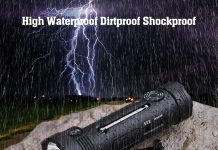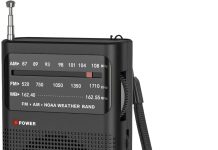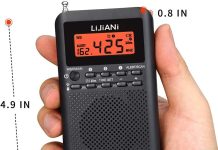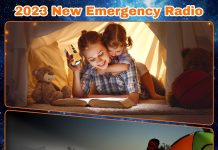Imagine a scenario: you’re out camping, surrounded by the soothing sounds of nature, when suddenly a storm rolls in with vengeance. You reach into your backpack for your trusty emergency weather radio, only to realize your phone is about to die. Panic sets in. Without communication, how will you ensure your safety? Well, fear not, because we have some exciting news for you. In this article, we will explore the question on everyone’s mind: Can emergency weather radios charge cell phones and other devices? Get ready to discover a potential game-changer for outdoor enthusiasts and emergency preparedness enthusiasts alike!
Review contents
What is an emergency weather radio?
An emergency weather radio is a specialized device designed to provide users with critical information during severe weather events and emergencies. It serves as a reliable source of alerts, advisories, and updates from official weather agencies, helping individuals stay informed and prepared for potentially dangerous conditions. These radios are specifically designed to withstand harsh weather conditions and provide a lifeline of communication in times of crisis.
Definition
An emergency weather radio is a portable, battery-operated device that receives broadcasts from the National Weather Service (NWS) and other authorized sources. It typically features a built-in receiver that can tune into specific frequencies used by the NWS to transmit weather information. This allows users to receive real-time updates on severe weather conditions, including tornadoes, hurricanes, floods, and other hazards.
Importance
Having an emergency weather radio is crucial because it provides a dedicated source of information during emergency situations. Unlike traditional radios or smartphones, these weather radios are specifically designed to receive and broadcast weather-related alerts and warnings. They can provide vital information about imminent dangers, evacuation notices, shelter locations, and other essential instructions. In remote areas with limited cellular coverage or unreliable power sources, an emergency weather radio can be a lifeline of communication, ensuring that individuals have access to critical information to protect themselves and their families.
Features
Emergency weather radios often come equipped with various features to enhance their functionality. These features may include:
-
Alert system: Most weather radios have an alert system that automatically activates when severe weather alerts are issued. It can emit loud sounds, flashing lights, or vibrating alerts to notify users of imminent dangers, even when they are asleep or away from the radio.
-
Battery-powered: To ensure uninterrupted operation during power outages or when portable power sources are not available, emergency weather radios are usually battery-powered. They may use replaceable batteries or rechargeable ones, depending on the model.
-
Backlit display: Many radios feature a backlit display, making it easy to read the information during nighttime or in low-light conditions.
-
Multiple channels: The ability to tune into different channels allows users to receive updates from local meteorological agencies, emergency management authorities, and even amateur radio operators during emergencies.
-
SOS function: Some advanced emergency weather radios include an SOS function that can be activated to signal distress during life-threatening situations. This feature is especially valuable in situations where immediate assistance is needed, such as in remote wilderness areas or during maritime emergencies.
How do emergency weather radios work?
Emergency weather radios utilize various technologies to receive and transmit weather-related information. Understanding how these radios work can help users make the most of their functionality and ensure they remain operational during emergencies.
Radio signals
Emergency weather radios rely on radio signals to receive broadcast information from official weather agencies, such as the National Weather Service. These signals are transmitted over specific frequencies assigned for weather information dissemination. The radios are designed to tune into these frequencies and pick up the broadcasts, decoding them to provide users with critical weather updates. By using specific frequency ranges, weather radios can efficiently receive alerts even in areas with weak or intermittent cellular coverage.
Battery power
Since emergency weather radios are often used during power outages or in remote areas without access to electrical outlets, they rely on battery power for operation. Most radios are designed to be energy-efficient, allowing them to operate for extended periods on a single set of batteries. It is essential to regularly check and replace the batteries in these radios to ensure they remain functional when needed.
Solar power
In addition to battery power, some emergency weather radios also offer solar power capabilities. These radios are equipped with solar panels that charge the internal batteries using sunlight. Solar power provides a sustainable and eco-friendly charging option, particularly in situations where replacement batteries might be scarce or in disaster-stricken areas with limited access to electrical power.
Can emergency weather radios charge cell phones?
As technology has evolved, some emergency weather radios now offer the capability to charge cell phones and other electronic devices. This additional feature can be incredibly valuable during emergencies, as it allows users to keep their communication devices powered up and functional.
Compatibility
Not all emergency weather radios have the ability to charge cell phones, so it is crucial to specifically look for models that offer this feature. Compatibility varies across different radios, and some may only be compatible with specific phone models or require adapters to charge certain devices. Therefore, it is essential to ensure that the radio you choose is compatible with your cell phone or any other device you intend to charge.
Charging options
Emergency weather radios that can charge cell phones usually offer multiple charging options. These may include USB ports, which allow users to connect their phones directly to the radio using a USB cable. Some radios may also feature wireless charging capabilities, enabling users to charge their phones by placing them on a designated spot on the radio. Additionally, radios with built-in power banks can be used to charge devices even when the radio itself is not connected to a power source.
What other devices can emergency weather radios charge?
While the primary focus of emergency weather radios is to provide weather-related information, some models offer the ability to charge other devices as well. This added functionality can be a significant advantage in emergency situations to keep essential devices powered up. Some devices that emergency weather radios can charge include:
Laptops
Certain advanced emergency weather radios come equipped with AC power outlets, enabling users to charge laptops or other power-hungry devices. This feature can be particularly helpful for individuals who need to continue working or accessing critical information during severe weather events or prolonged power outages.
Tablets
Emergency weather radios with USB charging ports can also charge tablets and iPads, providing extended device usage for communication, information, or entertainment purposes. Tablets can be essential tools for individuals who need to access maps, check weather updates, or communicate with emergency services during disasters.
Flashlights
Many emergency weather radios incorporate built-in LED flashlights, which can serve as a reliable source of illumination during power outages or in dark environments. These flashlights may feature various modes, such as SOS signals or adjustable brightness levels, to cater to different needs. The ability to charge the flashlight’s internal battery using the radio itself ensures that it remains operational when needed.
Radios
In addition to receiving weather alerts, emergency weather radios can also charge other radios or communication devices. This can be beneficial in scenarios where users need to stay connected with local news, emergency services, or other individuals during emergencies. The ability to charge radios ensures that reliable communication can be maintained even when traditional power sources are unavailable.
GPS devices
For individuals relying on GPS devices for navigation during severe weather or outdoor activities, the ability of emergency weather radios to charge these devices can be a game-changer. It ensures that GPS devices remain operational, allowing accurate positioning and navigation in challenging and potentially life-threatening conditions.
Are emergency weather radios portable?
Portability is a key factor when considering emergency weather radios, as they are intended to be used in a variety of situations and environments.
Size
Emergency weather radios generally come in compact sizes that make them easy to carry. Their dimensions are designed to fit comfortably in a backpack, emergency kit, or even a pocket. The goal is to ensure that users can have the radio with them at all times, ready to receive critical alerts and updates.
Weight
To ensure ease of transport and convenience, emergency weather radios are lightweight. Manufacturers strive to strike a balance between durability and weight, as radios need to withstand impact and exposure to elements while remaining portable.
Portable chargers
In situations where power sources are scarce or unreliable, having a portable charger for your emergency weather radio is highly advantageous. Portable chargers are typically compact, lightweight, and equipped with rechargeable batteries. They allow users to charge their radios without requiring access to traditional power outlets, ensuring continuous operation during emergencies.
What are the benefits of having a weather radio that charges devices?
Opting for an emergency weather radio with the capability to charge devices offers several notable benefits.
Emergency communication
During severe weather events and emergencies, communication is of utmost importance. Having a weather radio that can charge devices ensures that individuals can always stay connected. By keeping cell phones, two-way radios, or other communication devices powered up, users can make emergency calls, stay in touch with family and friends, and receive vital instructions from authorities.
Power source during disasters
Emergency weather radios that can charge devices provide a reliable power source when electricity is unavailable or unreliable. By utilizing the radio’s internal battery or power bank, users can charge essential devices and ensure their functionality. This can be particularly crucial for medical devices, such as CPAP machines or medication refrigerators, which require continuous power.
Versatility
The ability of emergency weather radios to charge various devices adds versatility to their functionality. In addition to receiving weather alerts, these radios can double as power banks, flashlights, or even radio transmitters. This versatility makes them invaluable tools for outdoor enthusiasts, campers, hikers, and anyone seeking to stay prepared for emergencies.
Are all emergency weather radios capable of charging devices?
Not all emergency weather radios have the capability to charge devices. Different models offer varying features and functionalities, so it is essential to carefully research and select a radio that meets specific requirements.
Product variations
Emergency weather radios come in a wide range of models and variations, each designed with different features and purposes. Some radios may prioritize lightweight and compact design over charging capabilities, while others may offer a comprehensive set of features that include device charging. It is important to review product specifications and ensure that a chosen model has the desired charging functionality.
Research and purchase
To find an emergency weather radio capable of charging devices, it is recommended to thoroughly research and compare available options. Read product reviews, check customer feedback, and consider personal requirements and budget. By doing so, users can make an informed decision and choose a radio that aligns with their specific needs.
What are the limitations of using an emergency weather radio to charge devices?
While emergency weather radios with device charging capabilities provide valuable features, it is important to be aware of their limitations.
Charging speed
Emergency weather radios may not be as efficient at charging devices compared to dedicated charging stations or power banks. The charging speed may be slower, particularly when charging power-hungry devices like laptops or tablets. Users should consider this limitation and plan accordingly in situations where quick and efficient charging is necessary.
Battery capacity
The internal battery capacity of emergency weather radios may not be as high as dedicated power banks. While they can provide sufficient power for small devices like cell phones or radios, charging larger devices or multiple devices simultaneously may deplete their battery quickly. Users should monitor the battery life and prioritize essential device charging to ensure uninterrupted communication and functionality.
Limited charging ports
Emergency weather radios with charging capabilities may have a limited number of charging ports. This means that users may not be able to charge multiple devices simultaneously, especially if they have different charging connectors or require higher charging speeds. It is important to consider the number of available charging ports and the specific devices that need to be charged simultaneously.
How can I extend the battery life of my emergency weather radio?
To maximize the battery life of an emergency weather radio, there are several power-saving tips and strategies that users can follow.
Power-saving tips
-
Lower the screen brightness: If the radio has a backlit display, reducing the brightness can significantly conserve battery power.
-
Limit unnecessary usage: Minimize the use of additional features, such as flashlights or radios, when not essential.
-
Regularly monitor the battery level: By being aware of the remaining battery life, users can plan and prioritize charging devices accordingly.
-
Activate power-saving mode: Some radios may offer a power-saving mode that optimizes performance and prolongs battery life. Enable this mode when necessary.
Battery replacement
Regularly checking and replacing the batteries in the emergency weather radio is essential to maintain its functionality during emergencies. Keep spare batteries in the emergency kit and ensure they are within their expiration dates. Follow the manufacturer’s instructions for battery replacement and disposal.
Alternative charging methods
In situations where traditional power sources are not available, alternative charging methods can help extend the battery life of an emergency weather radio. Consider using solar panels, hand-crank generators, or portable power stations to recharge the radio’s internal battery. These methods can ensure continuous operation even during prolonged power outages.
What are some popular emergency weather radios that can charge devices?
Several reputable brands offer emergency weather radios with device charging capabilities. While individual preferences and requirements may vary, here are a few popular options to consider:
Brand A
Brand A offers a range of emergency weather radios known for their durability and comprehensive features. Their radios include device charging capabilities, multiple charging ports, and long battery life. They emphasize user-friendly designs and are backed by positive customer reviews.
Brand B
Brand B specializes in compact and lightweight emergency weather radios with excellent portability. Their models are known for their power-saving features, solar charging options, and reliable device charging capacities. Brand B radios are favored by outdoor enthusiasts for their ruggedness and versatility.
Brand C
Brand C focuses on emergency weather radios with advanced technology and exceptional device charging capabilities. Their radios boast high-capacity power banks, fast-charging options, and compatibility with a vast range of devices. Brand C is recognized for its innovation in combining weather radio functionality with cutting-edge charging features.
In conclusion, emergency weather radios are invaluable tools for staying informed and prepared during severe weather events and emergencies. Their ability to receive real-time updates, provide alerts, and offer device charging capabilities makes them essential additions to any emergency preparedness kit. By understanding their features, functionalities, and limitations, individuals can make informed choices to ensure their safety and effective communication when it matters most.



























